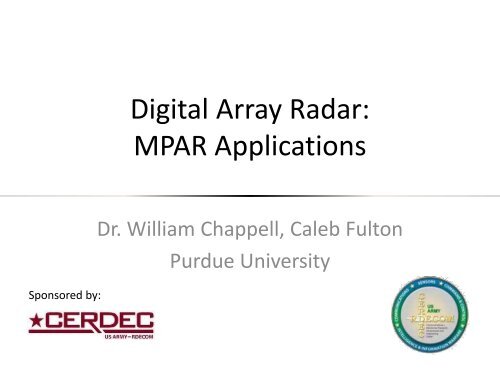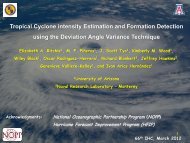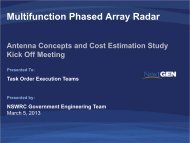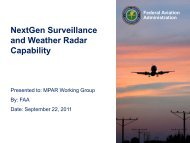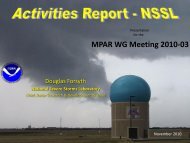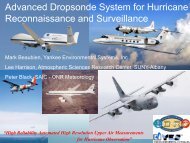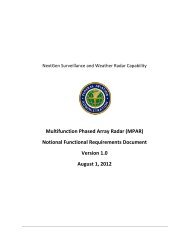Digital Array Radar: MPAR Applications
Digital Array Radar: MPAR Applications
Digital Array Radar: MPAR Applications
You also want an ePaper? Increase the reach of your titles
YUMPU automatically turns print PDFs into web optimized ePapers that Google loves.
IDEAS Microwave Laboratory<br />
Electrical and Computer Engineering<br />
<strong>Digital</strong> <strong>Array</strong> <strong>Radar</strong>:<br />
<strong>MPAR</strong> <strong>Applications</strong><br />
Sponsored by:<br />
Dr. William Chappell, Caleb Fulton<br />
Purdue University
• Introduction<br />
– What is a <strong>Digital</strong> <strong>Array</strong> <strong>Radar</strong><br />
– Benefits/ Drawbacks<br />
– Comparison of Architectures<br />
– History<br />
• Current DAR Effort<br />
– Approach<br />
• GaN/ SiGE<br />
– Current Status/ Results<br />
• Newer DAR Effort<br />
– Dual Polarization<br />
– New SiGe Components<br />
• The Future<br />
Overview of Presentation<br />
IDEAS Microwave Laboratory<br />
Electrical and Computer Engineering
What is a <strong>Digital</strong> <strong>Array</strong> <strong>Radar</strong>?<br />
IDEAS Microwave Laboratory<br />
Electrical and Computer Engineering<br />
Analog<br />
Digitization of the signal at each<br />
element. The combining of signals<br />
is done in the digital domain.<br />
<strong>Digital</strong><br />
Backend<br />
A/D<br />
D/A<br />
~<br />
Downconverter<br />
PA/ LNA<br />
01011<br />
11001<br />
01011<br />
<strong>Digital</strong><br />
11101<br />
01011<br />
10101<br />
Ethernet Output
Benefits<br />
• Digitization takes place at each element.<br />
<strong>Digital</strong> Benefits/Challenges<br />
IDEAS Microwave Laboratory<br />
Electrical and Computer Engineering<br />
– The combining and processing of signals is done completely in the digital domain.<br />
• This offers the ultimate in flexibility because the signals are combined digitally and can be<br />
dynamically changed as needed.<br />
– The connections between elements can be easily reconfigured.<br />
• This minimizes the amount of array specific analog components.<br />
– Allows for massively integrated analog systems and standardized digital systems<br />
• Advanced calibration/ processing allowed at each element<br />
– <strong>Digital</strong> equalization allows for very good element to element consistency across a<br />
wide frequency band.<br />
• Independent waveform synthesis capable at each element<br />
• Memory is allowed on the panel to store information selectively<br />
Challenges<br />
• Synchronization<br />
• Handling the amount of data that is generated on the panel
Overlapped Subarray Beamforming<br />
IDEAS Microwave Laboratory<br />
Electrical and Computer Engineering<br />
Intelligently organize beamformer to<br />
allow multiple, close‐in receive beams<br />
Practical, modular approach to beamforming –scales well to large arrays and a good<br />
approach. However it is fixed and hard to reconfigure once designed.
Overlapped Subarray<br />
(OSA) Digitization<br />
Can form on the order of M<br />
simultaneous beams with purely<br />
analog beamformers<br />
Antenna array (N elements)<br />
<strong>Digital</strong> Beamforming Architectures<br />
IDEAS Microwave Laboratory<br />
Electrical and Computer Engineering<br />
<strong>Digital</strong> at Every Element with<br />
Hierarchical <strong>Digital</strong> Backend<br />
Digitizer modules, intermediate<br />
processors, and final signal<br />
processor work together<br />
intelligently and flexibly<br />
T/R modules (N elements)<br />
M RF OSA<br />
beamformers<br />
RF<br />
Baseband<br />
<strong>Digital</strong><br />
Antenna array (N elements)<br />
T/R modules (N elements)<br />
N digitizer modules<br />
M down‐converters<br />
M digitizers<br />
Intermediate<br />
Processor<br />
Intermediate<br />
Processor<br />
<strong>Radar</strong> Signal Processor and<br />
final beamformer<br />
<strong>Radar</strong> Signal Processor and<br />
final beamformer
Hierarchical <strong>Digital</strong> Backend<br />
IDEAS Microwave Laboratory<br />
Electrical and Computer Engineering<br />
<strong>Digital</strong> Backend with<br />
Central Processing<br />
Bridges the gap between traditional, multibeam<br />
analog beamformers and the “ultimate”<br />
digital beamformer<br />
Hierarchical Backend<br />
Central<br />
Processor<br />
Strain is on the Central Processor to<br />
Handle the Influx of Data and<br />
Process the Entire <strong>Array</strong><br />
Brings computation closer to array face ands<br />
provides capabilities of beam forming and<br />
processing at different levels within the array
Introduction –Army <strong>Digital</strong> <strong>Array</strong> <strong>Radar</strong><br />
IDEAS Microwave Laboratory<br />
Electrical and Computer Engineering<br />
• Program goals:<br />
– Provide a generic platform for future<br />
advanced, low‐cost radars<br />
– Push for low‐cost integration of efficient,<br />
active components within radiating panel<br />
– Demonstrate multi‐functional approach to<br />
radar system design<br />
– Use modern digital transceiver technology<br />
for system flexibility<br />
– Develop intelligent digital backend<br />
architecture<br />
Contributions by Sierra Monolithics, Inc.,<br />
CREE Semiconductor, and Lockheed Martin
DAR Demonstrator<br />
IDEAS Microwave Laboratory<br />
Electrical and Computer Engineering<br />
At a high level, the digital radar program is trying to push technology to<br />
demonstrate where we see radar will be in years to come.<br />
Multifunctional : For satisfying multiple functional requirements, the flexibility of<br />
the digital domain is exceptionally useful. (<strong>Digital</strong> at Every Element)<br />
Highly Integrated : We are trying to distribute the digitization and the processing as<br />
close as possible to the apertures and have less than 1 analog IC per element. (SiGe)<br />
Flexibility : This approach minimizes the analog components while pushing the<br />
difficulties into the more inherently flexible digital domain. (Hierarchical FPGA’s)<br />
Low Cost : We are attempting to use commercial components and integration<br />
practices to remove the cost as much as possible. No liquid cooling or advanced<br />
packaging. (GaN)
DAR Program Concept V0<br />
IDEAS Microwave Laboratory<br />
Electrical and Computer Engineering<br />
GaN and<br />
SiGe<br />
Traditional<br />
Multilayer<br />
Board<br />
Antenna<br />
Initial Concept
DAR Program Concept V1<br />
IDEAS Microwave Laboratory<br />
Electrical and Computer Engineering<br />
<strong>Digital</strong><br />
ADC/DAC’s,<br />
FPGA’s, Memory<br />
Analog<br />
Antenna,<br />
GaN and SiGe<br />
CAD Representation of Final Prototype Subarray
DAR Program Demonstrator<br />
IDEAS Microwave Laboratory<br />
Electrical and Computer Engineering<br />
DAR Version I Prototype Subarray
Motivations –Army DAR Program<br />
IDEAS Microwave Laboratory<br />
Electrical and Computer Engineering<br />
Future <strong>Radar</strong> Needs<br />
• Low cost per element<br />
• High prime/RF power efficiency<br />
• Lighter, panelized form factors<br />
• Multiple concurrent functions<br />
• Beamforming agility<br />
Enabling Technologies<br />
• Wide‐bandgap semiconductors<br />
• Silicon integration in T/R modules<br />
– Less than 1 IC per channel<br />
• Commercial manufacturing<br />
– Surface mount integration<br />
• Cheaper, faster ADCs & processors<br />
• New digital architectures<br />
30‐Jun‐09<br />
Caleb Fulton<br />
Purdue University<br />
13
• 2006<br />
• 2007<br />
• 2008<br />
• 2009<br />
History<br />
IDEAS Microwave Laboratory<br />
Electrical and Computer Engineering<br />
– Started our effort with the antenna panel design under a contract with the ARMY<br />
(CERDEC). Loosely based on EQ36 radar specs for realistic bounds on development.<br />
– Cree started the development of GaN MMIC’s<br />
– Sierra Monolithics identified their current MIMO WIMAX SiGe IC as a candidate for the<br />
multichannel transceiver<br />
– Sierra begins creation of their next generation radar specific SiGe design, direct down<br />
conversion started<br />
– <strong>Digital</strong> backend effort is started at Purdue with FPGA, software and GUI development<br />
– First results of antenna panel presented at IEEE COMCAS conference (March 2008)<br />
– At the same conference, ELTA states that they have a working <strong>Digital</strong> <strong>Array</strong> <strong>Radar</strong>.<br />
Definitively states that this is their future.<br />
– Tracking Demo held at Lockheed Martin to show the functioning panel (Nov. 2008)<br />
– Presented Air Cooling of GaN in Panel and Tracking Results (IEEE MTT IMS)<br />
– Dual Pole Antenna Effort Started.
Basic Assumptions for DAR<br />
IDEAS Microwave Laboratory<br />
Electrical and Computer Engineering<br />
•In 5 to 10 years, one constant that will prevail is the ability to have increased<br />
processing capabilities in the digital domain.<br />
•Common platforms and modularity will be most easily handled in the digital<br />
domain allowing for easy resolution of disputes over shared apertures<br />
•Power is a driving factor in radars, so creating the highest power amplifier that<br />
commercial packages can handle is a prudent approach<br />
‐Duty Cycle and power are continuous needs for a system that is developing,<br />
since the capabilities are developing you would ideally have power overhead<br />
•MIMO systems have been driven into most if not all communication specs which<br />
has lead to massive integration, for example multiple SiGe transceivers on a chip<br />
By 2020, you do not want to have the best in technology that 2009 has to offer.<br />
So we are pushing in the newer directions that we see on the horizon.
Traditional Hybrid<br />
<strong>Radar</strong> Module<br />
~<br />
Low‐Cost DAR <strong>Radar</strong><br />
“2 Chip <strong>Radar</strong>” Solution<br />
<strong>Digital</strong><br />
Backend<br />
IDEAS Microwave Laboratory<br />
Electrical and Computer Engineering<br />
Advanced Integration<br />
A/D<br />
D/A<br />
~<br />
SiGe<br />
GaN<br />
~<br />
Traditional<br />
Electronics<br />
Massively integrated<br />
SiGe chip transceivers<br />
High Power<br />
GaN MMIC<br />
Image from Eurofighter’s radar<br />
http://www.airpower.at/news06/0922_captor‐e/index.html<br />
Remove Component Cost By Leveraging Commercial<br />
Integration Practices, remove T/R module<br />
The 400 Watt Radiating Laptop<br />
Planar “laptop‐like” Integration – Simple<br />
4 Layer Board for Analog Components
Control<br />
DAR Version I Subarray Architecture<br />
IDEAS Microwave Laboratory<br />
Electrical and Computer Engineering<br />
Quadrant<br />
Transceiver<br />
RF<br />
PC<br />
RS‐232<br />
Spartan<br />
3AN<br />
FPGA<br />
32 Mb<br />
SRAM<br />
JTAG<br />
Clock<br />
Dist.<br />
2x DAC<br />
Spartan<br />
2x DAC<br />
3A Spartan FPGA 2x DAC<br />
2x DAC<br />
3A Spartan FPGA<br />
2x DAC<br />
2x DAC<br />
3A Spartan FPGA<br />
2x DAC<br />
4x ADC 2x DAC<br />
3A FPGA<br />
32 Mb<br />
4x ADC 2x DAC<br />
SRAM 32 Mb<br />
4x ADC 2x DAC<br />
SRAM 32 Mb<br />
4x ADC<br />
SRAM 32 Mb<br />
4x ADC<br />
SRAM<br />
Xcvr. Header<br />
Xcvr. Header<br />
Xcvr. Header<br />
Xcvr. Header<br />
Xcvr. Header<br />
2x2<br />
MIMO 2x2<br />
Xcvr. MIMO 2x2<br />
Xcvr. MIMO 2x2<br />
Xcvr. MIMO<br />
Xcvr.<br />
2x2<br />
MIMO 2x2<br />
Xcvr. MIMO 2x2<br />
Xcvr. MIMO 2x2<br />
Xcvr. MIMO<br />
Xcvr.<br />
Header<br />
Header<br />
Header<br />
Header<br />
Header<br />
Header<br />
Header<br />
Header<br />
Sw. GaN<br />
Sw.<br />
Sw.<br />
Sw. GaN Sw.<br />
Sw.<br />
Sw.<br />
Sw. GaN Sw.<br />
Sw.<br />
Sw.<br />
Sw. GaN Sw.<br />
Sw.<br />
Sw.<br />
Sw.<br />
GaN<br />
GaN<br />
GaN<br />
GaN<br />
GaN<br />
GaN<br />
GaN<br />
GaN<br />
GaN<br />
GaN<br />
GaN<br />
GaN<br />
<strong>Digital</strong> CMOS<br />
SiGe<br />
GaN<br />
5) Synchronization<br />
<strong>Digital</strong> backend Control board<br />
designed, laid out, and<br />
populated in‐house<br />
Wrote firmware for FPGAs and<br />
software for host PC interface<br />
3) Silicon Integration Utilized<br />
integrated Sierra Monolithics<br />
2x2 WiMAX SiGe transceiver<br />
4) <strong>Digital</strong> Processing Quadrant<br />
boards perform data conversion<br />
and element‐level processing<br />
1) Antenna Panelization Antenna<br />
was designed, analyzed for mutual<br />
coupling, fabricated, and tested<br />
2) Plastic High Power Packaging<br />
Multi‐layer panel and plastic<br />
packaging designed to house efficient<br />
GaN T/R modules
High Power Organic Antenna <strong>Array</strong><br />
Plastic panel integration of wide band planar<br />
antennas and RF electronics board in one<br />
easily manufacturable unit.<br />
IDEAS Microwave Laboratory<br />
Electrical and Computer Engineering<br />
Composite multilayer polymer<br />
antenna<br />
•>35 Watts per element has been demonstrated<br />
with limited cooling on RF GaN antenna panel<br />
•Air cooling upto 50 % duty cycle with 25 watts<br />
radiated<br />
•Simulations show 80% efficiency at 7 Watts for<br />
GaN Amplifiers<br />
Large Area Integration<br />
8x8 antenna only array constructed<br />
•Plastic QFN packages are therefore possible
GaN Results<br />
Cost is Reduced Through Simplified Packaging<br />
• Comparison of Air Cooling Techniques<br />
• At least 10°C cooler than without a fan<br />
• All tested points above 22dB of Gain<br />
• Base Plate (Solid), Input Stage (Dash) and Output<br />
Stage (Dash‐Dot)<br />
IDEAS Microwave Laboratory<br />
Electrical and Computer Engineering<br />
Fan<br />
Piezo Fan<br />
Base Plate Temperature and Measured<br />
Efficiency<br />
Heatsink
November Results –Beamforming<br />
IDEAS Microwave Laboratory<br />
Electrical and Computer Engineering<br />
0<br />
-5<br />
Measured<br />
Purdue DAR <strong>Digital</strong> Beamforming -- Tx.<br />
Simulated<br />
Σ<br />
-10<br />
Transmit Strength, dB<br />
-15<br />
-20<br />
-25<br />
-30<br />
-35<br />
Δ<br />
-40<br />
-80 -60 -40 -20 0 20 40 60 80<br />
Angle, deg.<br />
Measured Versus Simulated <strong>Digital</strong>ly<br />
Formed Patterns from Panel<br />
Demo 1 – Generation of a pattern demonstrated for transmit and receive
Further Developments –Target Tracking<br />
IDEAS Microwave Laboratory<br />
Electrical and Computer Engineering<br />
• Send out 14 MHz wide linear frequency modulated (LFM)<br />
pulse from bottom two elements<br />
• Receive scattered wave on top two rows and demodulate<br />
waveforms in Matlab<br />
• Perform monopulse comparison test to determine angle<br />
& strength of return<br />
• Mutual coupling and clutter<br />
removed by recording these<br />
before introducing target<br />
• This simulates a simple<br />
MTI (moving target indicating)<br />
radar<br />
Demonstration of target tracking
Dual Polarization Variation of DAR<br />
IDEAS Microwave Laboratory<br />
Electrical and Computer Engineering<br />
The integrated SiGe transceiver is very<br />
useful for dual polarization<br />
There are two channels on one<br />
integrated circuit, so one IC handles<br />
both inputs from the antennas.<br />
DAC<br />
V<br />
V<br />
H<br />
DAC<br />
DAC<br />
DAC<br />
DAC<br />
DAC<br />
H<br />
DAC<br />
Direct Data Output<br />
DAC
Andrew W.’s slide<br />
DAR Dual Polarization Work<br />
IDEAS Microwave Laboratory<br />
Electrical and Computer Engineering<br />
Dual Pol Antenna Designed<br />
and Measured<br />
Adapted to Current DAR<br />
System<br />
H<br />
V<br />
H<br />
V<br />
Designed for simultaneous transmit on each<br />
polarization<br />
Sierra SiGe board redesign for<br />
panelization of new SMI I/Q<br />
transceiver<br />
Independent waveform synthesis at each antenna<br />
will allow for compensation of polarization<br />
mismatches to improve polarization metrics
Dual Polarization in Phased <strong>Array</strong>s<br />
IDEAS Microwave Laboratory<br />
Electrical and Computer Engineering<br />
Typical weather radar specifications:<br />
Specification<br />
Half power beam width<br />
Close in side‐lobe levels<br />
Differential Reflectivity Bias Error<br />
Integrated Cross‐Pol Ratio<br />
Value<br />
Results of Dual Pol Initial Analysis<br />
Theoretical ICPR < ‐55 dB for a 1 degree beam with<br />
35 dB sidelobes (Taylor weighting assumed)<br />
Best‐Case ICPR for 141x141 <strong>Array</strong><br />
IDEAS Microwave Laboratory<br />
Electrical and Computer Engineering<br />
Elevation (deg.)<br />
Azimuth (deg.)<br />
From a projection of a large array (~20,000 elements) based on the measured small array<br />
isolation (8 elements), the polarizat. compensation allows for theoretically great ICPR (
Conclusion<br />
IDEAS Microwave Laboratory<br />
Electrical and Computer Engineering<br />
We believe that the DAR approach is a good candidate for the<br />
<strong>MPAR</strong> program.<br />
DAR leverages technologies that we believe will be fully mature by<br />
the time that <strong>MPAR</strong> is activated.<br />
The main weakness (data handling and processing) should be a strength by<br />
the time of implementation<br />
DAR would be necessary to create a larger scale demo to show<br />
the array in operation. Only a 16 element panel created so far.<br />
Using the University as the system planner/integrator gives both<br />
the human resource development to feed into radar programs<br />
and the novel approaches that will push technology forward.
Mutual Coupling Measurement<br />
IDEAS Microwave Laboratory<br />
Electrical and Computer Engineering<br />
Mutual coupling<br />
Cross<br />
Polarization<br />
Couplings<br />
below this<br />
line (
Cost Analysis<br />
IDEAS Microwave Laboratory<br />
Electrical and Computer Engineering<br />
Cost of the major components of the panel:<br />
The GaN is expected to be at a dollar per Watt by 2013 ‐> $20 per element<br />
The Sierra Monolithic Transceiver IC’s are 4 to 6 dollars in bulk ‐> $5 per element<br />
The quadrant FPGA’s that we are using are 15 dollars per quadrant = $3.25 per element<br />
The controller FPGA is 40 dollar per panel = $2.5 per element


